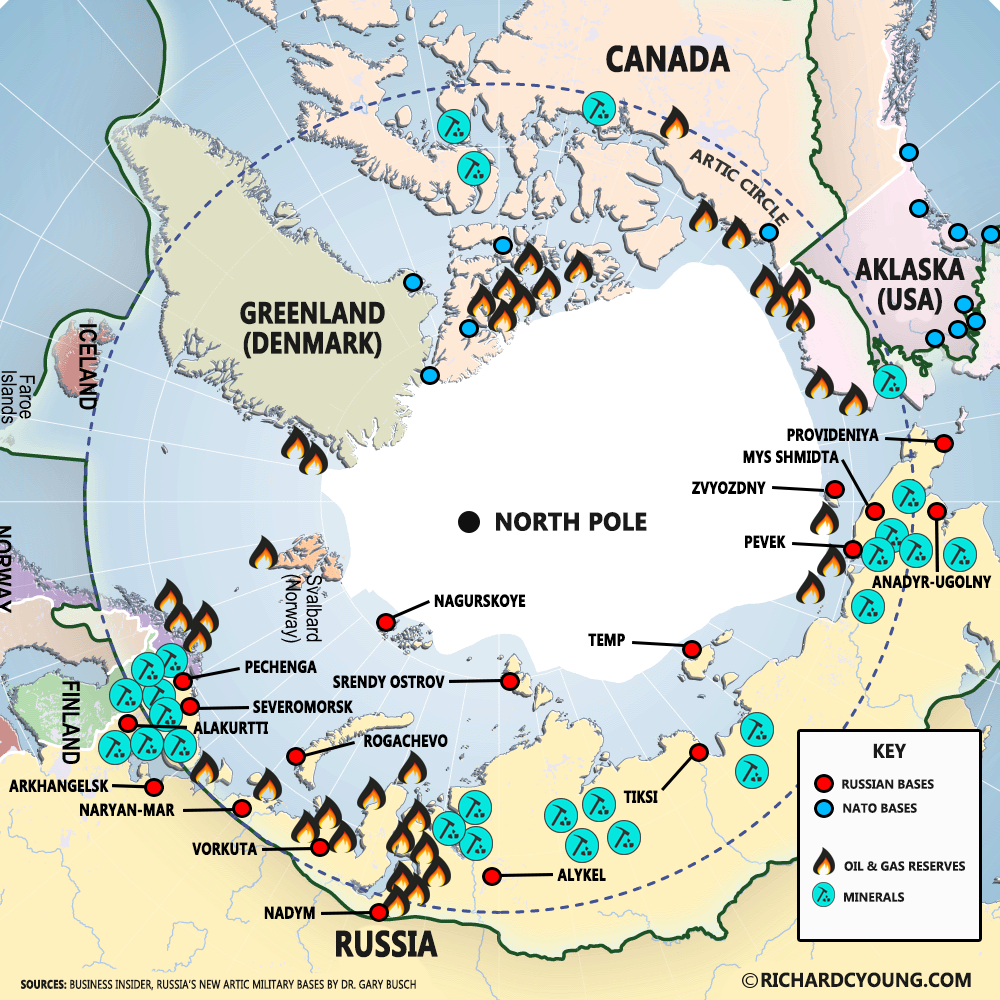
Map of Russian Military buildup in the Artic Circle along with Oil, Gas, and Mineral reserves. Click on the map for a larger view.
Admiral Paul F. Zukunft, Commandant of the U.S. Coast Guard, discussed the Frontline in the Arctic at the Center for Strategic & International Studies on May 3, 2017. Admiral Zukunft spoke about the need for more satellites to maintain domain awareness in the Arctic, 6 new ice breakers, and the need for a strategic plan for the Arctic.
When asked about Russia’s enhanced military posture in the Arctic, new military bases, special forces deployed, and new nuclear ice breakers being built, Admiral Zukunft says, “If we look at this as an Arctic game of chess, they have all their pieces on the chessboard, all we have is a pawn and a rook.” He continued saying, “they’ve got us at checkmate if this becomes a militarized domain.”
New Artic Shamrock military base on Franz Josef Land.In April, The BBC wrote that Russia had unveiled its newest military base Arctic Shamrock on Franz Josef Land, and has plans to build other bases at Rogechevo, Cape Schmidt, Wrangel Island, and Sredniy. The Russian military sees the Artic as a strategic region.
A military airstrip is also under construction in Franz Josef Land, called Nagurskoye.
Russia is building four other Arctic military bases – at Rogachevo, Cape Schmidt, Wrangel and Sredniy.
Experts say the melting of Arctic sea ice – generally attributed to climate change – is making the polar seas more accessible for shipping. That could make it easier to prospect for untapped energy and minerals in the region.
Check out Russia’s Virtual Tour of a New Military Base in Alexandra Land.
The Arktika, Russia’s new nuclear-powered ice breaker.In June of 2016, Popular Mechanics wrote about Russia launching the world’s most powerful icebreaker in St. Petersberg. It is the first of 3 planned nuclear-powered icebreakers Russia is building
The Arktika, launched in St Petersberg, is the first of a new class of ships known as Type LK-60YA, ordered by Russian state nuclear agency Rosatom (eventually there will be three vessels). Its task will be to smash a path through the ice of the Northern Sea Route. Raw power counts for a lot in icebreaking, and by bringing 80,000 hp (60 megawatts) to bear, Arktika will be able to break through floating ice almost ten feet thick. The icebreaker will lead convoys along a route that otherwise would be impassable.
“There are no icebreakers equivalent to Arktika anywhere in the world,” Rosatom CEO Sergey Kirienko said at the launching ceremony. He went on to claim that it is more advanced than anything afloat. “The icebreaker Arktika means real new opportunities for our country.” […][…] The US currently has three icebreakers operated by the Coast Guard. These are non-nuclear, and much smaller than the Russian vessels—they weigh in at 13,000 tons and have a quarter of the power of the Arktika. Even so, the Polar Star can force a passage through ice more than six feet thick. Yet the disparity has some commentators worried about an “icebreaker gap” that would give the Russians an advantage in the Arctic.
“We’re not even in the same league as Russia right now,” Coast Guard Commandant Paul F. Zukunft told Newsweek in 2015. The concern is that the Russians will be better placed to exploit gas and oil deposits on the Actic seabed, an area Russia has been seeking to claim as her own. […]




